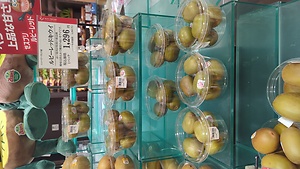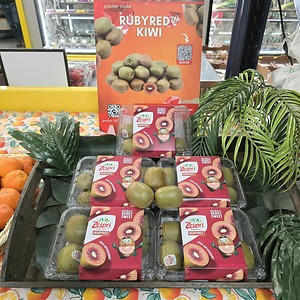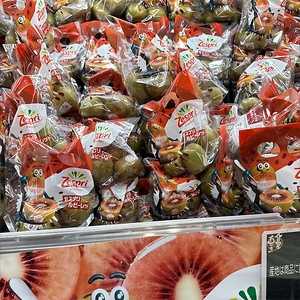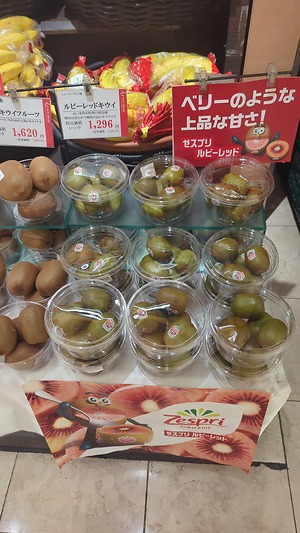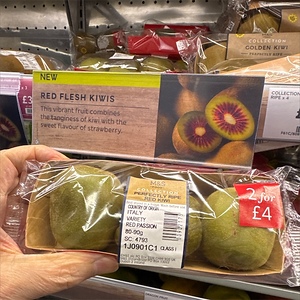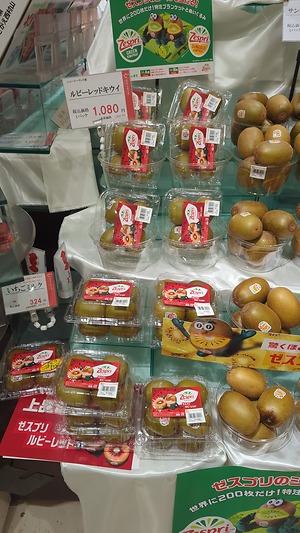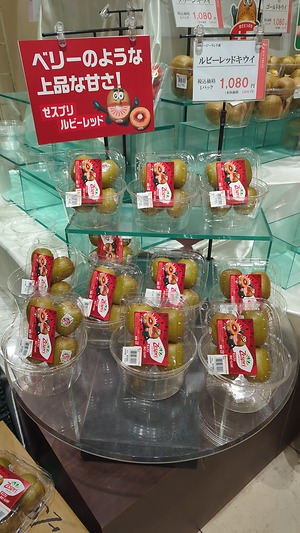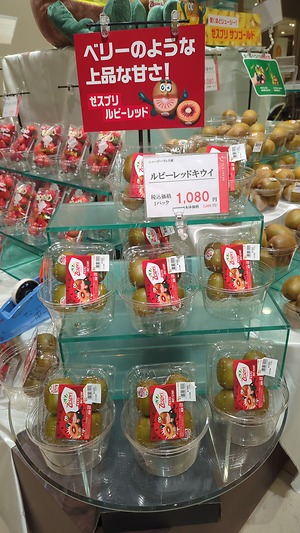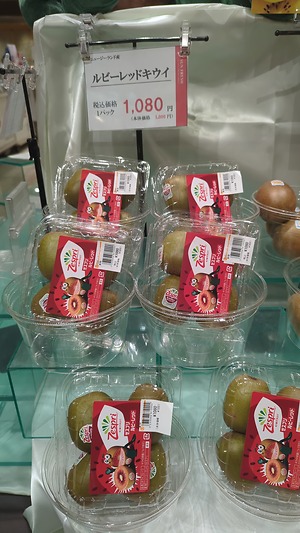

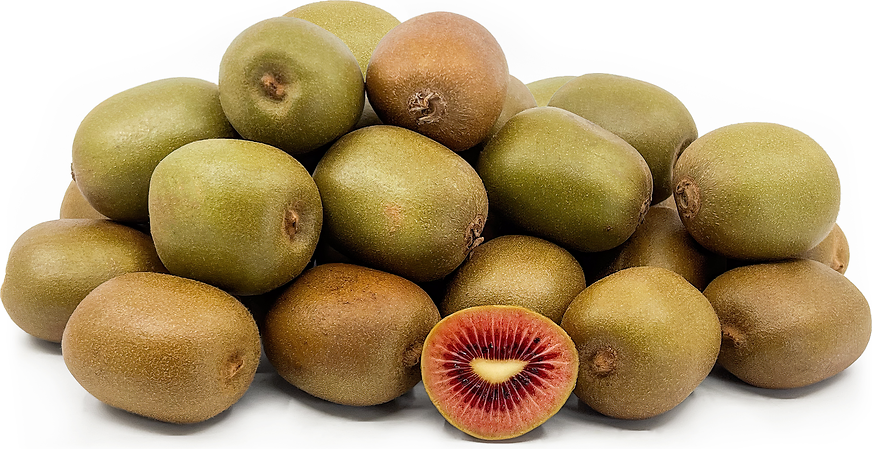
RubyRed™ Kiwi
Estimated Inventory, ea : 0
This item was last sold on : 06/14/25
Description/Taste
Zespri RubyRed™ kiwifruit is smaller in size than commercial green and gold varieties, averaging 5.7 to 6.2 centimeters in length and 4.2 to 4.9 centimeters in diameter, and has an oval to ovate shape with sloping blunt, curved ends. The fruits generally weigh 62.3 to 87 grams and occasionally showcase a distinct dent on the bottom of the fruit. Zespri RubyRed™ kiwifruit has delicate, thin, smooth, and taut skin, radiating variegated shades of brown and olive green with numerous lenticels. The skin is also covered in short, red-brown, fine, downy hairs concentrated on the stylar end of the fruit, giving the surface a velvety feel. These hairs are weakly adhered to the skin and can be easily removed. Underneath the skin, the flesh is solid, tender, and aqueous, with a succulent, soft consistency. Zespri RubyRed™ kiwifruit is known for its distinctly pigmented flesh. The flesh will vary in coloration, but overall, the variety bears saturated pink and red hues with a dark red, crimson ring surrounding a yellow oval center. The dark red ring is also speckled with tiny, edible black seeds. Select Zespri RubyRed™ kiwifruits that are unblemished with taut skin and are semi-firm to the touch. The fruits have high sugar content, ranging from 18 to 24 Brix, and moderate acidity, creating a sweet, berry-like flavor.
Seasons/Availability
Zespri RubyRed™ kiwifruit is available for a short season from April to May, sometimes extending into June.
Current Facts
Zespri RubyRed™ kiwifruit, botanically classified as Actinidia chinensis, is a red-fleshed variety belonging to the Actinidiaceae family. The trademarked fruits are a curated creation from Zespri International Limited and were released in the early 21st century as a new pigmented kiwifruit. Zespri RubyRed™ kiwifruit showcases vibrant red and pink hues created from the natural presence of anthocyanins in the flesh, contributing to a distinct appearance and sweet, berry-like flavor. The variety was also selected for commercial markets for its disease resistance, mainly the bacterial vine disease Psa-V. Since its official release in 2020, Zespri RubyRed™ kiwifruit has been exclusively sold through Zespri International Limited and exported for sale in Asian markets. The variety offers a sweeter, less tangy flavor than green kiwis and is favored by consumers for its berry-like notes, a taste that distinguishes it from the famous gold kiwis. Presently, Zespri RubyRed™ kiwifruit is only available for a short season and offered in targeted markets, but eventually, the variety will be expanded and available to markets worldwide.
Nutritional Value
Zespri RubyRed™ kiwifruit is a source of vitamin C to strengthen the immune system and fiber to regulate the digestive tract. The fruits also provide vitamin E to protect the cells against free radical damage, vitamin A to maintain healthy organ functioning, vitamin K to assist in faster wound healing, potassium to balance fluid levels within the body, and other nutrients, including magnesium, folate, and calcium. The variety's red-pink flesh indicates the presence of anthocyanins, natural pigments in the flesh with antioxidant-like properties to protect the cells against the damage caused by free radicals and improve overall well-being. Beyond the flesh, the fruit's seeds are edible and contain omega-3 fatty acids, vitamin E, and the actinidin enzyme to reduce bloating and digest proteins. The fruit's skin is also edible, a source of fiber, vitamins C and E, and polyphenols.
Applications
Zespri RubyRed™ kiwifruit has a sweet, berry-like flavor suited for fresh and cooked preparations. The entire fruit is edible, including the skin, and kiwis can be bitten into like an apple, peeled, chopped, or halved, and the flesh scooped from the skin with a spoon. Zespri RubyRed™ kiwifruit is typically consumed fresh, and the flesh is popularly mixed into fruity medleys, salsa, grain bowls, and salads. The fruits are also cut into decorative shapes and displayed on appetizer platters, used as a topping over cakes and chia puddings, layered into parfaits, or frozen into popsicles as a refreshing treat. In addition to fresh preparations, Zespri RubyRed™ kiwifruit can be added to the center of cakes, muffins, and bread or simmered into jellies, jams, and syrups. Try adding the fruits to smoothies, milkshakes, and fruit juices or slicing portions of the flesh and dropping them into carbonated beverages for increased visual appeal. The fruits can also be sliced into unusual shapes and frozen into ice cubes. In Asia, whole, peeled kiwis are popularly placed into the center of a hollowed cake filled with cream, so when the cake is sliced, solid rings of kiwi flesh are displayed at the center of the cake. Kiwis are also used as a meat tenderizer, as the flesh contains actinidin, an enzyme that dissolves proteins. Zespri RubyRed™ kiwifruit pairs well with fruits such as strawberries, coconut, melons, and bananas, meats such as beef, pork, and poultry, and nuts including almonds, walnuts, and pine nuts. The fruits ripen quickly and can soften at room temperature for 2 to 3 days. It is recommended to store Zespri RubyRed™ kiwifruit in the refrigerator, where the fruits will ripen in 5 to 7 days and last for up to 10 days.
Ethnic/Cultural Info
Zespri International Limited is the world's largest marketer of kiwifruit and is the exclusive exporter of kiwis from New Zealand to countries worldwide. Kiwis are New Zealand's largest horticultural export and were first introduced to the country in 1904. Isabel Fraser, a teacher from Whanganui on the North Island, encountered kiwis in China while visiting her sister in the Yangtze Valley. Fraser worked with British naturalist Ernest Henry Wilson to source the seeds, which were planted by a Whanganui grower named Alexander Allison in 1905. Throughout the early 20th century, kiwis began to grow in New Zealand, and in 1928, horticulturist Hayward Wright eventually created the green kiwifruits that are popular today. Despite their now-famous name, kiwifruits were once known as Chinese gooseberries and were affectionately nicknamed hairy berries. Over time, the fruit's name was renamed kiwifruit after New Zealand's national flightless bird, as the kiwi bird shared a fuzzy, brown, and round exterior reminiscent of the fruit. RubyRed™ kiwifruits were named after their unusual coloring and berry-like flavor. The name was selected after consumer feedback in Asia in the early 21st century, and it was suggested that the fruit's flesh reminded them of a precious gem, symbolizing the fruit's rarity and limited availability.
Geography/History
Zespri RubyRed™ Kiwifruit was developed in New Zealand in partnership between Zespri International Limited and the New Zealand Institute for Plant & Food Research. Red-fleshed kiwis were born from a natural mutation of gold kiwis found in the wild in China and were selected for cultivation in 1984. Later in 1997, New Zealand breeder Russell Lowe and other breeders at the Institute for Plant & Food Research began working on creating new red-fleshed kiwi varieties. Lowe and the team spent several years breeding, trialing, and evaluating red-fleshed varieties, but the entire process was altered in the early 21st century when the bacterial vine disease Psa-V began decimating kiwi crops. Between 2005 to 2007, a variety named Zes006 was crossed with CK51_09 at the Te Puke Research Center in New Zealand, and this cross yielded fruits in 2009 with pigmented flesh, flavor, and overall visual appeal. The new variety was further analyzed and tested for several years, labeled as Zes008, and it was found to have some resistance to Psa-V, making it a suitable cultivar for commercial production. In 2019 and 2020, Zes008 was soft-launched in select markets in New Zealand, Singapore, and Japan under the name Zespri Red™. The variety saw success in these test markets, and after consumer feedback, the fruit's marketing name was changed to Zespri RubyRed™ in 2022. Today Zespri RubyRed™ kiwifruits are grown in New Zealand and are exported to Japan, China, and Singapore. The variety is only available for a limited season, but Zespri International Limited plans to expand production to release the red-fleshed fruits worldwide.



